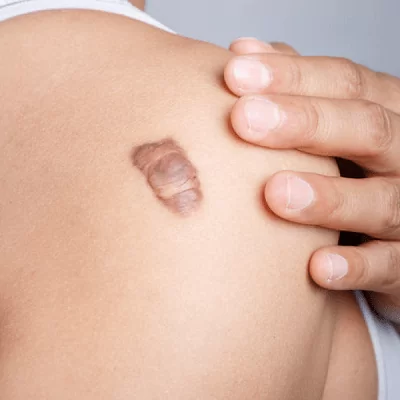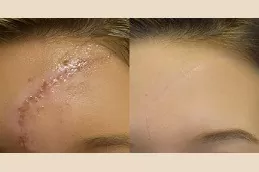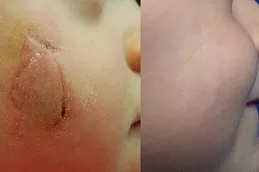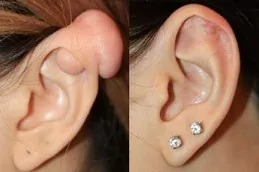Results of Keloid Treatment:
Treatment can lessen the size of the keloid. It can mitigate manifestations like itching and pain. Now and again, treatment can help dispose of the keloid.
Indeed, even after effective treatment, a few keloids return. On the off chance that you follow your dermatologist’s bearings, you will lessen the odds of a keloid returning. It will likewise assist you with getting the best outcomes from your treatment.
Why do Keloid Scars Appear?
- A keloid scar occurs due to uncontrolled growth of the dermis at the site of skin damage. Such a process can happen in people with a high content of an enzyme in the body responsible for the production of collagen. Excessive protein intake can also impact the formation of keloids, for example, with sports nutrition or excessive consumption of meat.
- After an injury, burn, piercing or surgery, a hypertrophic scar first appears, and then it can degenerate into a keloid. The growth of such a scar begins after 10 or 12 weeks of healing, and the area of the scar tissue is much larger than the resulting wound. Spontaneous keloids are especially common on the face, neck, upper body, in sternum.
- As a rule, such a scar gives its owner unpleasant sensations: itches or hurts. The colour of the scar is red-cyanotic. The skin covering the keloid can be thinned, does not contain sweat and sebaceous glands, hair follicles and pigment cells, this area of the skin never tan and does not grow hair on it.
Which Doctor to Contact?
Depending on the type of scar you have, you may need to contact a different doctor. If a keloid scar appears after trauma or surgery, you must consult a surgeon. In case of spontaneous scars or their appearance at the site of skin altered due to acne or boils, you can consult a dermatologist.
If keloid scars are formed in people with endocrine system diseases like obesity and diabetes, you should consult a therapist, endocrinologist, or genealogist.
Treatment of Keloid Scars at our Clinic:
At the Sydney Royal Clinic, a versatile Scars & Keloid Treatment in Georgia, Tbilisi is carried out to achieve the maximum therapeutic effect. The course of treatment is prescribed after the diagnosis and analysis of the patient’s medical history.
- Surgical removal of the keloid is ineffective; moreover, mechanical damage to the tissue stimulates the growth of collagen and promotes the re-growth of the scar.
- Today it is possible to get rid of scars using progressive methods. Come to our clinic, and experienced specialists will help you remove scars using modern equipment and the latest technologies and medicines without relapse.
Keloid Scar treatment in Georgia include:
- Laser resurfacing
- Surgical removal
- Cryotherapy
- Medication
Laser resurfacing:
It can be an option for people who don’t want to go for a surgical procedure. With laser treatment relapse is unlikely. Laser treatment works by directing a laser beam on the scar which flattens the keloid and fades its colour.
It is often used in combination with other treatments.
Surgical removal:
Surgical removal of keloids involves cutting out the keloids and it’s not a permanent solution as there is no guarantee that the keloids will not return. For this reason, surgical removal is often combined with another form of treatment like cryotherapy which will prevent the scar from returning.
Cryotherapy:
It works by freezing the keloid but saving the skin underneath. This treatment reduces the size and height of the keloid. It freezes the keloid from the inside out and diminishes the hardness. It works better on small keloids, and you may need to take three or four sessions to see the best results.
Medication:
The most popular medication for keloid treatment is corticosteroids, which will shrink the keloid when injected into the scar. You may need to get a series of injections, and there is also the risk of getting the scar back. This treatment may also be combined with other treatments to get the best results and prevent relapse.
Keloid Treatment FAQ’s:
Can Keloids Go Away?
Usually, thick and irregular, keloid scars rarely disappear on their own. Dermatologists stress the significance of preventing keloids from forming in the first place because they can be difficult to treat.
How Do You Stop Keloids From Growing?
Your dermatologist may advise using a silicone gel pad or pressure pad on a wound to aid in healing. Following a skin injury, adults should follow these precautions for six months, and children for up to eighteen months.
What Injections Prevent Keloids?
Dermatologists may directly inject a corticosteroid solution into a keloid or hypertrophic scar to help minimize its size. The amount of scar tissue under the skin is decreased by steroids because they break the bonds that hold collagen fibers together.
How To Get Rid Of Keloids?
A versatile scars & keloid treatment in Georgia, Tbilisi is performed at the Sydney Royal Clinic in order to maximize therapeutic effect. Keloid scar treatments include laser resurfacing, surgical removal, cryotherapy, and medication.
What Causes Keloid Scars?
Any type of skin injury, including burns, hair removal, acne, injections, insect bites, and minor scratches and bumps, can cause keloids to grow. They are not contagious or cancerous, but they can sometimes form for no apparent reason.
What Are The Side Effects Of Keloid Injections?
Injections of corticosteroids may cause permanent skin color changes, spider veins, and skin thinning. Using liquid nitrogen to freeze small keloids may help minimize or eliminate them. Treatments may need to be repeated.
How Painful Is Keloid Surgery?
Keloid removal causes very little discomfort. Many times, patients can go back to work right away after the procedure. Usually, stitches come out in five to seven days. To lessen the possibility of a recurrence, doctors might plan steroid injections after the procedure.
Cost of Keloid Scars Treatment:
It is impossible to accurately determine the Cost of Keloid Treatment in Georgia USA because varied factors impact the price, like the size and location of keloid, number of sessions required to treat the keloids and the treatment technique used.
The doctor’s experience and expertise, and accreditations of the clinic also impact the cost. Consult the doctor and discuss the cost and technique of treatment to be used in detail.
Book an Appointment
If you are worried about your keloid scars and want help getting rid of them, contact Royal Clinic Georgia now to get help from the most competent professionals with Scars & Keloid Treatment in Georgia, Tbilisi .





